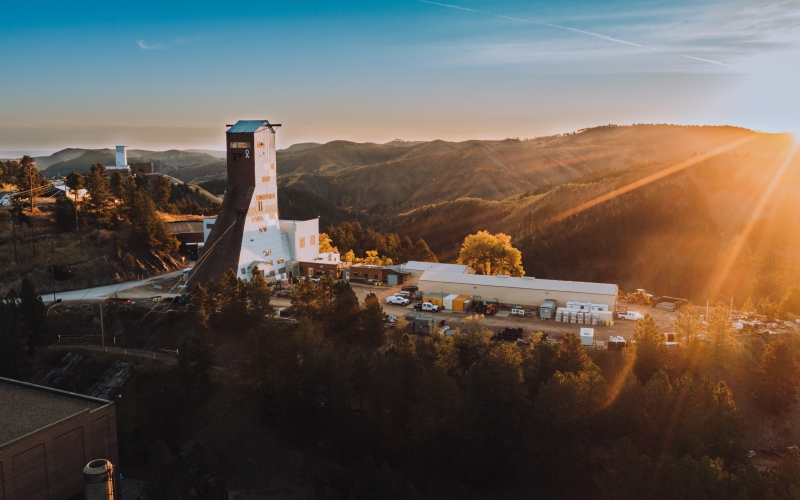
Researchers explore the fields particle physics, earth and life sciences at Sanford Lab.
As the nation’s deepest underground laboratory, Sanford Underground Research Facility (SURF) serves as a touchstone for the scientific community. Under nearly a mile of rock, physicists shield their sensitive experiments from the cacophony of cosmic rays from the Sun. Biologists hike through miles of drifts to far-off collection sites, gathering samples of water swimming with microscopic life forms called extremophiles. And geologists get the coveted experience of scrutinizing deep rock layers face-to-face.
This year, SURF formally created the SURF User Association (Association) to bring these researchers together. The Association, which currently has 288 active members, aims to promote open discussion between users and SURF management and foster community between users of diverse disciplines.
“As a research institution, it’s important that we have a vehicle to connect with researchers on a consistent basis,” said Jaret Heise, science director at SURF. Heise noted that communication channels existed previously, but the creation of a formal user association invites even greater participation from users.
The Association also encourages users to act as ambassadors for underground science at SURF on the world stage.
“As science communities define their priorities for the next decade, SURF and the scientists that perform research at our facility have a voice in that strategic planning,” Heise said. “Our users can advocate for the importance of underground science, and in particular they can advocate for the SURF facility as a location for future underground science.”
In December, the Association selected nine members to serve on the Executive Committee, which will conduct day-to-day business. The Executive Committee includes early career researchers, as well as representatives from physics, earth and life sciences, and six experiments operating at SURF.
Megan Smith, an earth scientist at Lawrence Livermore National Laboratory, is a member of the Association’s inaugural Executive Committee. Smith studies the Earth’s deep subsurface to better understand the potential of geothermal energy. In her field, direct access to deep underground rock is extremely valuable.
“As geologists, we only get a tiny, tiny sampling of what's under the surface of the earth. We have to use small data points to make inferences about processes that occur at different depths and pressures,” Smith said. “The ability to examine the subsurface is invaluable. It hugely expands our capabilities to test our models of the Earth.”
As a member of EGS Collab/SIGMA-V, Smith has traveled to SURF multiple times since 2017. On Smith’s first trip, the team found a promising location for their experiment. On subsequent expeditions underground, they lined the drift with sensitive instruments to track how water travels through small pathways in the rock. Over the years, these tests have been instrumental in analyzing and refining the group’s models of the subsurface, informing future geothermal energy projects.
Smith recognized the importance of acting as an ambassador for underground science facilities.
“Working at SURF is an incredible opportunity. There are so many cool science questions that can only be answered in this type of space,” Smith said.
Ralph Massarczyk, a physicist at Los Alamos National Laboratory (LANL), is also a member of the SURF User Association’s Executive Committee. He began traveling to SURF six years ago, when he was a postdoc helping with the early construction of the Majorana Demonstrator.
Now a staff scientist at LANL, Massarczyk describes the growth he has seen at SURF: “From a researcher’s standpoint, things have become more user-friendly through the years. This Association will help users, especially the younger researchers, to have a point of contact to ask questions about how things work at SURF.”
Massarczyk said he looks forward to sharing research opportunities at SURF with colleagues in Europe, who may not know much about the facility. “SURF is getting more and more international, and this association is a nice podium for me to help spread out the word,” Massarczyk said.
Massarczyk noted that SURF is garnering local attention, too.
“The first time I came to Lead, I remember going to a restaurant and talking with locals. When they heard I worked at the lab, they would tell me which level they used to work on when it was a mine,” Massarczyk recalls. “Now, when I talk with people, they ask which experiment I’m with, and when I say ‘Majorana,’ they know the name. They’re familiar with the experiments. I would say the lab has helped shaped the town. It went from a mining town to people being excited about the science.”
Moving forward, the SURF User Association aims to connect and support our research communities, whether they are studying subatomic particles, microscopic extremophiles, vibrations in the rock and other questions for which the underground environment is a unique window.
For more information about the SURF User Association, visit our website: https://www.sanfordlab.org/researchers/surfuserassociation.
